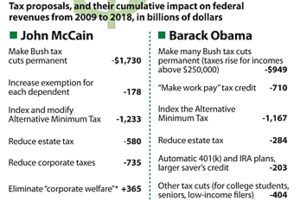Income-tax bracket creep, through the decades
The top rate, 35 percent, is half what it once was. But it's higher now than in the Reagan years.

SOURCE: Tax Policy Center estimates, based on plans as described by candidates' economic advisers. Rich Clabaugh – Staff
Below is a list of major changes in US income taxes over four decades, and of the presidents who proposed them. Throughout this time, federal tax receipts have averaged 18 percent of US gross domestic product, with a low of 16.4 percent (in 2004) and a high of 21 percent (in 2000).
1964, John F. Kennedy
Taxes cut to rates ranging from 16 to 77 percent of income.
1969, Richard Nixon
Minimum tax established to reduce tax avoidance by rich Americans. Separate rates established for single payers. Top rate of 70 percent.
1978, Jimmy Carter
Income brackets adjusted for inflation, so fewer people are taxed at high rates. Top rate of 70 percent.
1981, Ronald Reagan
Taxes and number of brackets reduced. Top rate 50 percent.
1986, Ronald Reagan
Simplification brings number of brackets to three. Top rate falls to 28 percent.
1990, George H.W. Bush
Alternative minimum tax boosted and top bracket raised to 31 percent.
1993, Bill Clinton
Tax rates rise, with new high brackets of 36 and 39.6 percent.
2001 and 2003, George W. Bush
Taxes cut, with top rate falling to 35 percent by 2006. A bottom rate of 10 percent introduced.
Sources: US Department of Treasury and Tax Policy Center
